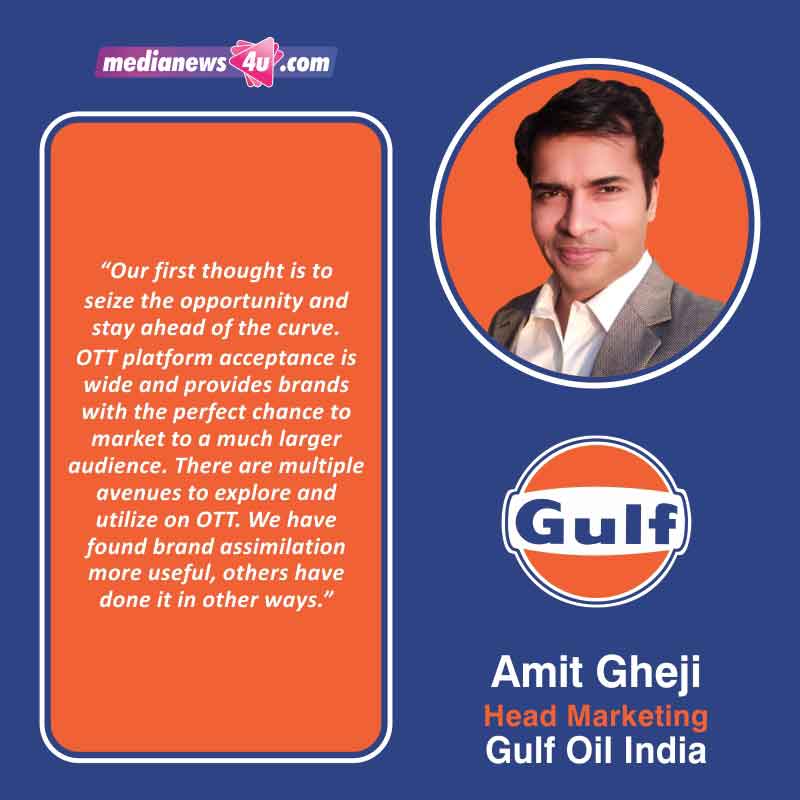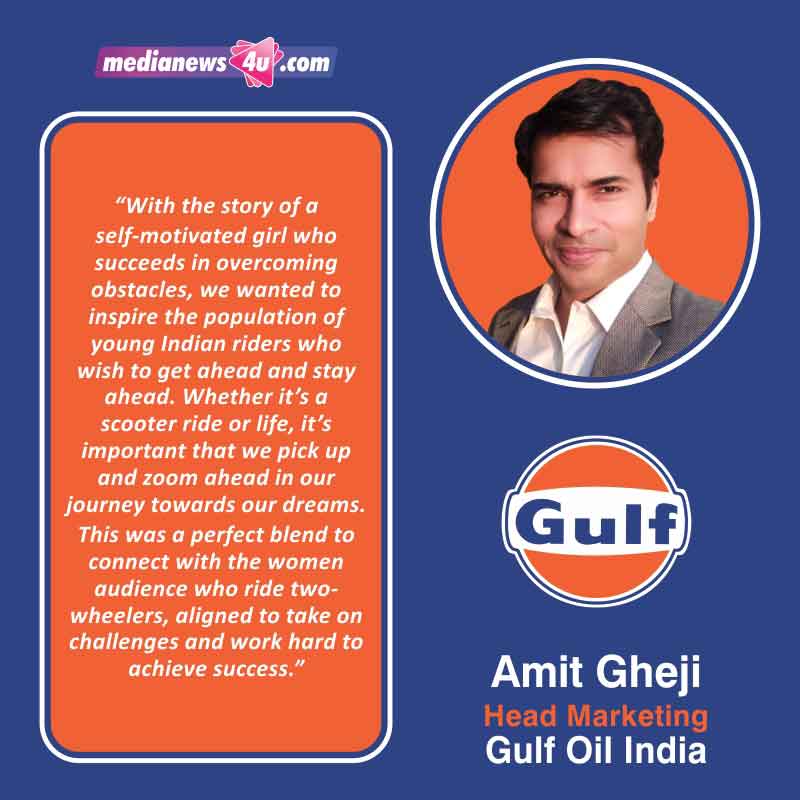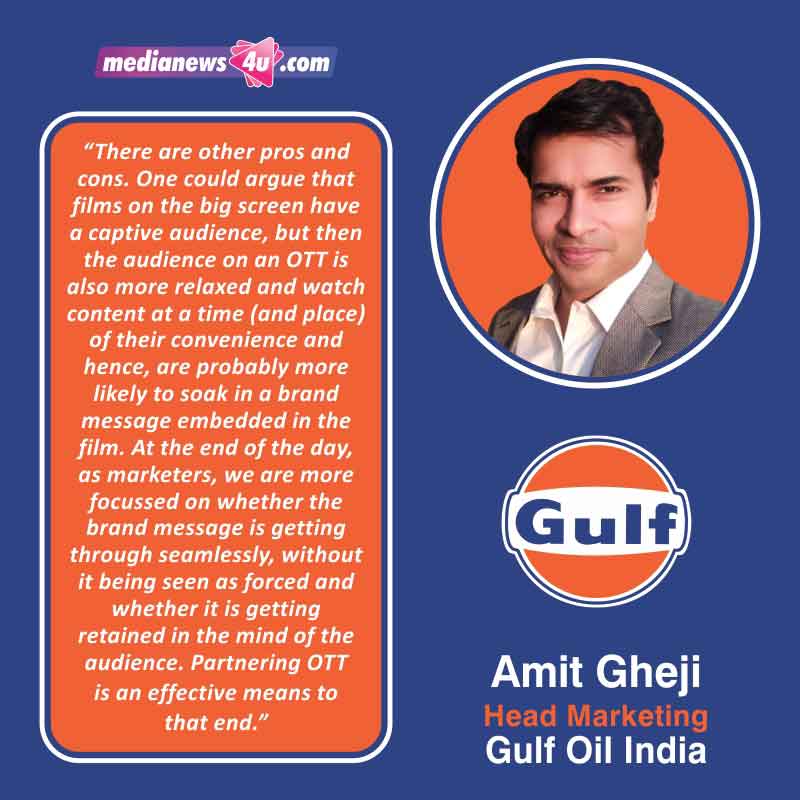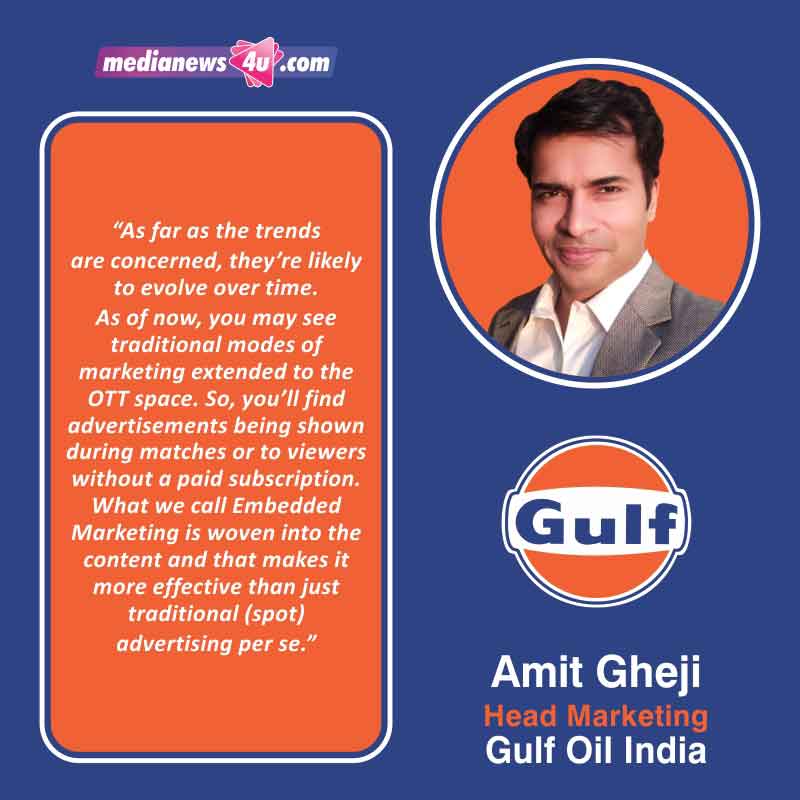Gulf Oil Lubricants India Ltd (GOLIL), part of the Hinduja Group, is an established player in the Indian Lubricants Industry. Gulf Oil International (GOI), the parent of GOLIL, owns the Gulf brand globally (except USA, Spain, and Portugal). Previously a part of Gulf Oil Corporation Limited today, GOLIL as part of the parent company GOI, enjoys a presence in over 100 countries. The company has a pan India distribution network with more than 70,000 retail touchpoints.
Brands and movies have a long history of working together. Product placement, often known as in-film advertising, is a relationship between a brand and a film. Theatres have re-opened in full swing after a nine-month break following the successful releases of Akshay Kumar’s Sooryavanshi and Rajnikant starrer Annaatthe. The future of theatre releases, though, remains uncertain.
In the last two years, enormous changes have occurred as a result of Covid-19, ranging from lifestyle, education to entertainment. The culture of seeing a play or a movie in auditoriums/theatres has faded. Due to this change, over-the-top (OTT) platforms have become mainstream entertainment channels, as evidenced by the increase in their viewership. As a result of this surge in viewership, brands are increasingly spending big bucks to get featured in OTT shows and films. As the rules of marketing change and viewers’ attention fades, recently, Gulf Oil India partnered with the new Hindi sports drama film Rashmi Rocket that was released on the OTT platform.
Amit Gheji – Head Marketing – Gulf Oil India speaks exclusively to mediaNews4U on this partnership with ‘Rashmi Rocket’, the measurement of ROI on the digital platform, and much more…
In the past one and a half years, the OTT viewership has grown manifolds, as a brand your thoughts?
The pandemic has been a blessing for the OTT industry, as new concepts like binge-watching became a very common activity since everyone was forced to stay indoors. Improved WiFi and internet accessibility, affordable subscription, and unlimited access to a world of content have further bolstered this. Our first thought is to seize the opportunity and stay ahead of the curve. OTT platform acceptance is wide and provides brands with the perfect chance to market to a much larger audience. There are multiple avenues to explore and utilize on OTT. We have found brand assimilation more useful, others have done it in other ways.

As a brand what made you to partner with Rashmi Rocket for the OTT release?
The theme of the film resonated with the values we stand for as a brand. Rashmi Rocket is about a small-town girl who overcomes social barriers to become a national-level athlete. She remains strong in the face of adversity and ultimately thrives.
With the story of a self-motivated girl who succeeds in overcoming obstacles, we wanted to inspire the population of young Indian riders who wish to get ahead and stay ahead. Whether it’s a scooter ride or life, it’s important that we pick up and zoom ahead in our journey towards our dreams.

This was a perfect blend to connect with the women audience who ride two-wheelers, aligned to take on challenges and work hard to achieve success.
What are the advantages of the brand associating with films which are on OTT?
Films have a large viewership that benefits brands. If one has the opportunity to partner with a film that resonates with the brand’s values and promise, then the association is more valuable. If the film happens to have a popular actor/actress in the lead, that is then a delight. There’s an indirect endorsement for the brand by the character that’s played by the actor/actress in the film. Moreover, the mass appeal that comes with it helps brands reach audiences far and wide. In the case of Embedded Marketing, an added benefit is that the seamless assimilation of the brand into the film ensures that it cannot be skipped or ignored.
The shelf life of OTT platforms is much higher compared to the traditional medium.
The reason to partner OTT releases is because you can monitor viewership on the digital platform as compared to a theatrical release?
The reason essentially was because the audience relocated themselves to OTT with the onset of the pandemic. Monitoring and statistics are additional advantages. Today, the viewership and engagement measurement have become increasingly important as digital marketing is slowly taking up a larger mind space as well as share of budget/ wallet spends.
There are other pros and cons. One could argue that films on the big screen have a captive audience, but then the audience on an OTT is also more relaxed and watch content at a time (and place) of their convenience and hence, are probably more likely to soak in a brand message embedded in the film. At the end of the day, as marketers, we are more focused on whether the brand message is getting through seamlessly, without it being seen as forced and whether it is getting retained in the mind of the audience. Partnering OTT is an effective means to that end.

What is the ROI value on this?
The ROI is measured in a similar way whether we partner with OTT or when we partner with traditional mediums. Marketers will look for a lift in the brand equity mind measures and/or purchase intent. The ROI value will differ from campaign to campaign and it depends a lot on the creative messaging and the expected action from the consumer. OTT and in-film brand integration are mediums to deliver the same.
Today more and more brands are moving toward the OTT platforms and what are the trends you are seeing especially in India and in the regional markets, your thoughts?
On OTT, we are spoilt for choices. That’s the basic appeal of the platforms. Moreover, it is available anytime, anywhere at subscription rates that are affordable to many. So, it is in the favor of brands to continue targeting this segment.
As far as the trends are concerned, they’re likely to evolve over time. As of now, you may see traditional modes of marketing extended to the OTT space. So, you’ll find advertisements being shown during matches or to viewers without a paid subscription. What we call Embedded Marketing is woven into the content and that makes it more effective than just traditional (spot) advertising per se.

Now that theatres are back in business, how are brands viewing this?
I’m sure all brands are elated, as are we. Brands are ready to do what is best for them and mould themselves in ways that the situation demands. Post-pandemic, I think, we all know better than to rely on a single approach.

















